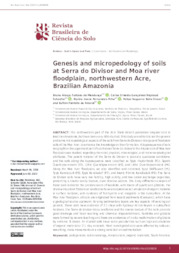Genesis and micropedology of soils at Serra do Divisor and Moa river floodplain, northwestern Acre, Brazilian Amazonia.
Genesis and micropedology of soils at Serra do Divisor and Moa river floodplain, northwestern Acre, Brazilian Amazonia.
Autoria: MENDONÇA, B. A. F. de; SCHAEFER, C. E. G. R.; FERNANDES-FILHO, E. I.; SIMAS, F. N. B.; AMARAL, E. F. do
Resumo: The northwestern part of the Acre State (Brazil) possesses singular soils in Brazilian Amazonia, but have been very little studied. This study aimed to discuss the genesis and some micropedological aspects of the soils from Serra do Divisor and adjacent floodplain soils of the Moa river, to enhance the knowledge on their formation. A toposequence of soils ranging from the uppermost part of sub-Andean Serra do Divisor to the Alluvial soils of Moa river floodplain was studied, regarding chemical, physical, mineralogical, and micromorphological attributes. The parent material of the Serra do Divisor is basically quartzose sandstone, and the soils along the toposequence were classified as Typic Haplorthods (P1), Spodic Quartzipsamment (P2), Lithic Quartzipsamment (P3), and Lithic Quartzipsamment (P4). Along the Moa river floodplain, we also identified and collected, Typic Udifluvent (P5), Typic Kandiudult (P6), Typic Kandiudalf (P7), and Arenic Plinthic Kandiudult (P8). The Serra do Divisor soils have very low fertility, high acidity, and low cation exchange capacities, presenting a coarse sandy texture, even shallow pedons. The X-ray diffraction analysis of these soils indicates the predominance of kaolinite, with traces of quartz and gibbsite. The shallow mountain Podzols on sandstone have an expressive accumulation of organic material in surface horizons, with evidence of ferrihydrite and imogolite in the subsurface. At the Moa river floodplain, all soils are originated from recent sediments (Cenozoic), which have a geological source upstream. Varying sedimentary layers are key aspects influencing soil genesis. Those soils have evidence of 2:1 clays with hydroxyl-Al interlayers in subsurface horizons. The Serra do Divisor steep landforms and the coarse texture of the soils promote good drainage and favor leaching and chemical impoverishment. Kaolinite and gibbsite were formed by severe leaching and there are evidences of in situ neoformation of gibbsite by extreme Si losses. All studied soils have some peculiarities such as high accumulation of organic material or 2:1 clay minerals. Most investigated soils were affected by colluvial, reworking, mass movements or a strong variation on sedimentation.
Ano de publicação: 2020
Tipo de publicação: Artigo de periódico
Unidade: Embrapa Acre
Palavras-chave: Amazonia Occidental, Amazônia Ocidental, Floodplains, Formación del suelo, Gênese do Solo, Llanuras sujetas a inundaciones, Materia orgánica del suelo, Matéria Orgânica, Micropedologia, Micropedology, Mineralogia, Mineralogía del suelo, Northwestern Acre, Planície de inundação, Rio Moa (AC), Serra do Divisor (AC), Soil formation, Soil mineralogy, Soil organic matter, Várzea, Western Amazon
Observações
1 - Por padrão são exibidas publicações dos últimos 20 anos. Para encontrar publicações mais antigas, configure o filtro ano de publicação, colocando o ano a partir do qual você deseja encontrar publicações. O filtro está na coluna da esquerda na busca acima.
2 - Para ler algumas publicações da Embrapa (apenas as que estão em formato ePub), é necessário ter, no celular ou computador, um desses softwares gratuitos. Sistemas Android: Google Play Livros; IOS: iBooks; Windows e Linux: software Calibre.
Acesse outras publicações
Acesse a Base de Dados da Pesquisa Agropecuária (BDPA) para consultar o acervo completo das bibliotecas da Embrapa.

